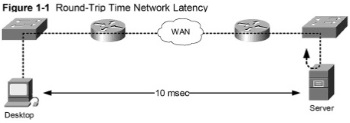Standard Network Path Metrics
By Shaun Hummel
Selecting performance metrics are key to an effective performance monitoring
strategy. Before assigning performance metrics, we need to understand the
typical industry standard performance metrics used. The performance metrics
are used to detect performance problems and to determine causes. The following
describes the most common network performance metrics.
Network Latency
The latency of a network is a general term that refers to the amount of time
(delay) a packet spends on the wire from the time a client makes a request
minus the server and desktop processing time. Latency is most often expressed
as round-trip time (RTT) between source to destination. The ping program is
used to verify interface status and RTT latency as shown with Figure 1-1. The
latency measured is travel time from where the ping was issued and return time
from the destination (server). The network latency is a cumulative metric based
on all delays across the network to the server. The application response time is
derived from network latency along the path and server processing delay.

Propagation Delay
Network latency is the cumulative delay caused by fixed and variable delays.
The fixed delays include propagation, device processing and serialization delay.
Propagation delay is the delay resulting from the total distance between routers
on the network. It is based on the speed of light (186,000 miles per second) and
the distance between locations. The propagation of a signal through copper and
fiber media is approximately two thirds the speed of light. The distance
between source and destination is divided by two thirds the speed of light. This
is estimated to be an average of 6 microseconds per km or 10 microseconds
per mile. The increased number of router hops resulting from suboptimal routing
and network design problems contribute to increased propagation delay.

Device Processing Delay
Device processing delay is the amount of time to process packets at each
network device between source and destination. The packets arrive where they
are processed and then forwarded toward the destination. The standard
network devices include routers, switches, wireless devices, load balancers
and WAN optimizers. The ratings throughput for network devices is based on
processor, memory and platform architecture. The primary solutions to minimize
device processing delay is hardware upgrades to increase device capacity.
Serialization Delay
Serialization delay is the delay that occurs when placing bits on the network
media (wired/wireless). It is determined by the packet size and the link speed. The
serialization delay is lower with faster campus links and higher with slower WAN
links. The amount of serialization delay on low speed circuits is compounded
when there are multiple router hops.
Queuing Delay
Queuing delay is a variable delay caused by data packets waiting in a device
queue for servicing. The amount of queuing delay will vary based on network
congestion, packet size and how busy the ingress and egress queues are when
the packet arrives. The amount of queuing is minimized with faster link
speed between network devices.
Jitter
Jitter is a variable delay that applies to voice and video traffic only. Jitter
results from voice packets waiting in a queue for variable amounts of time for access
to the network media. Jitter is the amount of variation (msec) in delay between
packets caused by queuing. The voice and video traffic classes require constant
delay for proper service quality. The recommendation is to use de-jitter buffers
at the receiving node to reduce jitter. The de-jitter buffer size should be set for a
constant delay affect and according to traffic load. Setting buffer size too low
causes packet loss and setting them high causes excessive delays.
| 
